
About three blocks from our apartment is a large garden and the Palais Longchamp. The garden is quite popular for kids and families to play on the playgrounds, ball games, pony rides, carousel, etc. It used to be a zoo, but the animals were removed some years ago due to noise. The Palais is actually a folly with two large wings, housing the Natural History Museum and the Fine Arts Museum, closed for renovations. 
From wwww.marseille-tourisme.com:
This historic building, inaugurated in 1869, commemorates the arrival of
the water of the canal between the river Durance and Marseille. On the same site, it brought together the Museum of Fine Arts, which before was in the former Bernadines chapel, the Museum Natural History, a botanic park and a zoo. The rich decoration of the building evokes the abundance and fertility brought 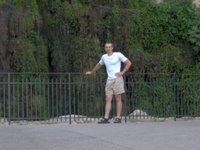 by the water of the canal. Here sculpture has a dominating role, and this work was entrusted to the greatest artists of that period. The famous animal sculptor Antoine Louis Barbye created the lions and the tigers of the entrance, and the monumental fountain in the centre of the row of columns is the work of Jules Cavelier. It represents the river Durance surrounded by figures symbolizing the vines and wheat on a cart pulled by the bulls of Camargue.
by the water of the canal. Here sculpture has a dominating role, and this work was entrusted to the greatest artists of that period. The famous animal sculptor Antoine Louis Barbye created the lions and the tigers of the entrance, and the monumental fountain in the centre of the row of columns is the work of Jules Cavelier. It represents the river Durance surrounded by figures symbolizing the vines and wheat on a cart pulled by the bulls of Camargue.
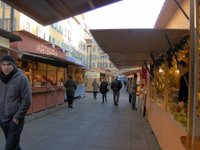
 Today at school, we had one of our free outings. We went to the Foire Aux Santons, or market. We left at nine, but it didn't open until 10, so we had a coffee at the Vieux Port. There were six students and one of the teachers. There were about 20 stalls, all with very similar santons, different sizes.
Today at school, we had one of our free outings. We went to the Foire Aux Santons, or market. We left at nine, but it didn't open until 10, so we had a coffee at the Vieux Port. There were six students and one of the teachers. There were about 20 stalls, all with very similar santons, different sizes.Santons are clay figurines that come either painted, or unpainted (less expensive). They come in many different sizes (small painted ones about 7 euros each), and some have real clothes, and other real implements. These can be a hundred dollars or more. Many of them are the traditional Nativity figurines, plus the butcher, the baker, and the candlestick maker.
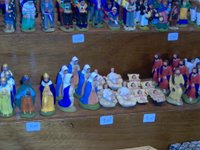
Betchya didn't know they were at the birth of Jesus did ya?
For more information on Santons
History of Santons
http://www.beyond.fr/themes/santon.html
More Santon examples.
http://www.simplytreasures.com/

This is the cathedral/basilica built on top of one the highest hills in the middle of Marseille. The views from the cathedral are spectacular- one can see all of Marseille. It used to be where the lookout post was. A chapel was built on the hilltop in the 13th century, and became a priory for the monks of St Victor. In the 16th century, the church was fortified, to defend against a threatened invasion by Charles V of Spain. It was built between 1853 and 1864. (side note- the foundation stone was laid September 11th) On top of the belfry is a huge golden statue of the Virgin holding a child. From Wikipedia:
The interior is decorated with inlaid marble, mosaics and murals. On the walls, there are many plaques from sailors and their families, sometimes just saying Merci. There are also hanging from the ceiling many small model boats.This ornate Neo-Byzantine church sits atop the signal hill of La Garde, the highest natural point in Marseille, being a 162 m (532 ft) limestone outcrop on the south side of the Vieux Port. As well as being a major local landmark, it is the site of a popular annual pilgrimage every August 15th (Assumption). Local inhabitants commonly refer to it as "la bonne mère (the good mother)." The basilica took five years to build and required 170,000 tons of material, including 23 shiploads of marble and
porphyry from Italy.
An ex-voto is a votive offering to a saint or divinity. It is given in fulfilment of a vow (hence the Latin term, short for ex voto suscepto, "from the vow made") or in gratitude or devotion. Ex-votos are placed in a church or chapel where the worshipper seeks grace or wishes to give thanks. Shrines decorated with ex-votos are often the destinations of pilgrimages. Ex-votos can take a wide variety of forms. In the church of Notre-Dame-de-la-Garde in Marseille, France, the site of a major local pilgrimage, the ex-votos include paintings, plaques, model boats, war medals and even football shirts given by players and supporters of Olympique de Marseille, the local team.
(side note: Allez l'OM! Droit au but!)
Our Lady of the Guard belongs to all the inhabitants of Marseille. "Our Good Mother" pays particular attention to the people of the sea: she looks out to sea and the port entrance.
And finally, because every Cathedral needs to have a website
From the article "Marseille's recipe for composure" sent to me by Genevieve.
This scruffy port has most of the ingredients associated with the recent rioting and car burning in French cities: high unemployment, a huge immigrant community, considerable poverty. Yet Marseille emerged relatively unscathed compared with cities like Paris, Toulouse, and Lyon.'Everyone in France speculated that Marseille would be the first to burn. You need to live here to understand why it did not.' Residents insist that Marseille is different from other large urban centers in France. They have centuries of experience in managing immigration, they say - 2,600 years in total, if you count back to the city's founding by Greek traders. Marseille, the second largest city in France, is French the way New York is American: The city is defined by the waves of immigrants who settled here, chief among them Italians, Armenians, and Muslims and Jews from Algeria, Tunesia and Morocco....Personally, I'm not sure how un-racist Marseille is, I think it depends on where you come from. I, as a blond-haired blue-eyed American, feel that most likely I get treated differently than an African woman wearing a head scarf. But in general I think people are pretty relaxed and willing to help, even if they can't understand what I am asking for half the time in grocery store.
It is impossible not to notice the diversity of this city. In one glance across the sidewalk here you can spot West Africans selling handicrafts, crusty French seamen emerging from the port, and French-Arab youths in track suits strutting into a fast-food joint.
Fraise! Fraise! Small, round, red, fruit?
Sorry, I don't understand.
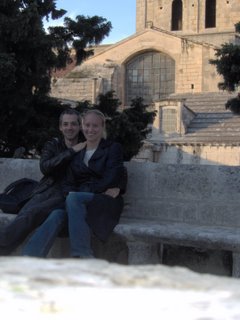
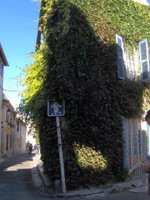 The next morning we woke up, had breakfast at a café- coffee and croissants. You can buy croissants at bars or at bakeries. If it is at all possible, buy them at a bakery and then go to the bar to eat them with your coffee.
The next morning we woke up, had breakfast at a café- coffee and croissants. You can buy croissants at bars or at bakeries. If it is at all possible, buy them at a bakery and then go to the bar to eat them with your coffee.We walked around in the early morning, it was quite beautiful
 with the light on the old stone buildings. We walked along the river and went to the Museon Arlaten. As it was the first Sunday of the month, it was free. Apparently the museum was founded by Frédéric Mistral using his Nobel Prize money in 1904, renovating a 16th century building. It was a very interesting museum, with tons of old portraits, costumes, household items, etc. It also has information about local customs, folklore, and traditions. The guides were dressed in traditional costume and apparently very eager for us to leave so they could go to lunch.
with the light on the old stone buildings. We walked along the river and went to the Museon Arlaten. As it was the first Sunday of the month, it was free. Apparently the museum was founded by Frédéric Mistral using his Nobel Prize money in 1904, renovating a 16th century building. It was a very interesting museum, with tons of old portraits, costumes, household items, etc. It also has information about local customs, folklore, and traditions. The guides were dressed in traditional costume and apparently very eager for us to leave so they could go to lunch.Afterwards, we checked out of our hotel, had lunch, and walked around Arles further before going to the Musée de l'Arles Antique. This Museum used to be located in the old part of the city, but was recently moved to a huge building. It had many artifacts from Ancient Arles, mostly concerning the Roman period. There were huge mosiacs, sarcophagus, statues, and household implements. We didn't have much time as I would have liked since the museum was closing. Then we drove home. It was a great weekend.

For my birthday and our two year anniversary (the day after), Alain and I decided to spend a weekend in the nearby city of Arles. It is about an hour away by tollway, to the northwest.
Here is the description from the guidebook.
Few other towns in Provence combine all the region's charms as well as Arles. Its position on the Rhône makes it a natural, historic gateway to the Camargue. Its Roman remains, such as the arena and Constantine's baths, are complemented by the ocher walls and Roman-tiled roofs of later buildings. A bastion of Provençal tradition and culture, its museums are among the best in the region. Van Gogh spent time here in 1888-9, but Arles is no longer the industrial town he painted. Visitors are now its main business, and entertainment ranges from the Arles festival to bullfights.
We left Saturday morning and arrived a little before noon. It was a challenge to find our hotel, as the roads in the old section (within the Roman walls) are very narrow, one way and winding. We finally managed to find it, checked in, and went to eat lunch. Our hotel was very close to the Amphitheater. After lunch, we set off to explore the city.
First we went to the Amphitheater. It is described as one of the best-preserved monuments of  Roman Provence. It is 446 ft by 351 ft, and could seat 21,000 people. "The floors of some of the internal rooms were decorated with mosaics, the better to wash down after bloody affrays." Those Romans, they think of everything. Interesting point- the arena is the actually sandy area in the middle, the surrounding part is the Amphitheater. In summer they hold Bullfights, some where they kill the bulls, others not. It is free for residents of Arles, and there were some in there reading books, like at a college campus. Today I think I will go read my Statistics book in a 2000-year old monument....
Roman Provence. It is 446 ft by 351 ft, and could seat 21,000 people. "The floors of some of the internal rooms were decorated with mosaics, the better to wash down after bloody affrays." Those Romans, they think of everything. Interesting point- the arena is the actually sandy area in the middle, the surrounding part is the Amphitheater. In summer they hold Bullfights, some where they kill the bulls, others not. It is free for residents of Arles, and there were some in there reading books, like at a college campus. Today I think I will go read my Statistics book in a 2000-year old monument....
After, we went to see the Cloisters of St-Trophime. Not sure really what it was. I think a  monastery. Not much in the way of explanations. All signs in French museums are in French. No English or any other language for other visitors. Anyway, there was an exposition of UNESCO World Heritage site pictures, of all former Roman cities and monuments. Right outside in the Place de la Republic is the city hall, a huge Egyptian Obelisk, and the Eglise St-Trophime. It is a "fine Romanesque church" with a 12th century portal of the Last Judgement, including saints and apostles.
monastery. Not much in the way of explanations. All signs in French museums are in French. No English or any other language for other visitors. Anyway, there was an exposition of UNESCO World Heritage site pictures, of all former Roman cities and monuments. Right outside in the Place de la Republic is the city hall, a huge Egyptian Obelisk, and the Eglise St-Trophime. It is a "fine Romanesque church" with a 12th century portal of the Last Judgement, including saints and apostles.
The rest of the day we just walked around, tried to find some place to eat. We finally found a  place called L'Escalade, close to the amphitheater. It said that it opened at 6:30. Whenever you find a restaurant that says that, don't believe them. They are lying. Technically, there might be someone there at that time, but they are not open and not ready to serve food. Me, I was hungry at 6. We waited until 6:45 to arrive. They let us in, but boy did we feel in the way. We returned to the hotel and fell asleep immediately.
place called L'Escalade, close to the amphitheater. It said that it opened at 6:30. Whenever you find a restaurant that says that, don't believe them. They are lying. Technically, there might be someone there at that time, but they are not open and not ready to serve food. Me, I was hungry at 6. We waited until 6:45 to arrive. They let us in, but boy did we feel in the way. We returned to the hotel and fell asleep immediately.
Example: Je mange la pomme. (I eat the apple.)
Je la mange. (I eat it)
In the passé composée form it gets interesting. Since apple is the direct object, the ending of the verb has to accord with it.
Je l'ai mangée.
But if there is no direct object, such as I ate yesterday, it is just
J'ai mangé hier.
It can be difficult to guess what gender the noun is, as there doesn't seem to be any logical assignment of the gender.
lipstick : le rouge à lèvres
tampon: le tampon
(side note: tampon can also be stamps, which leads for some interesting store signs. Kind of like the Supermaxi grocery store in Ecuador.)
The passé composée verbs can be conjugated with être (to be) or avoir (to have). When I took Intro to French back at UVA, I mistakenly thought that it was a direct translation of english, such as
Je suis entrée (I was entering)
But no, it is entered. Note the extra e at the end of entrée when a woman is speaking.
For a man: Je suis entrée.
For we: Nous sommes entrés (for a mixed gender group)
but for a group of women: Nous sommes entrées.
It can be very confusing sometimes. Especially as you cannot hear the difference in the pronounciation, only can guess by the context and who is talking. Same as with the 3rd person singular he/she il/elle, and the 3rd person plural they ils/elles, many times, but not always, the verb endings sound the same.

Lançon-de-Provence is a small town about 30 minutes north west of Marseille. Lancoun De Prouvenco in the old Provencal language. It i s very cute, my idea of what a perfect Provençcal village should be like. I am sure there are nicer ones, but not "real" ones. It also happens to be where Alain's parents live, where he grew up, and where we will be getting married.
s very cute, my idea of what a perfect Provençcal village should be like. I am sure there are nicer ones, but not "real" ones. It also happens to be where Alain's parents live, where he grew up, and where we will be getting married.
http://www.provenceweb.fr/e/bouches/lancon/lancon.htm
The website states that there are 6,786 inhabitants. There is a small church, where we will be getting married, plus another small chapel. Correction, where the marriage blessing will take place. You can only get "married" one place, and that is the city hall. The surrounding countryside has olive trees and grape vines. Alain's parents have a fig tree, a cherry tree, and two olive trees. One thing that I love about the french language is the names for the trees- le olivier, le figiuer, and le cerisier. All of the houses are built out of brown sandstone? rocks? and the shutters are painted bright colors, blues, purples, pinks, reds, browns. There are several boulangeries (bakeries, required, I really do believe it is a law stating for X numbers of inhabitants you have to have Y number of bakeries), pizza places, coiffures, war memorials, and so on. Many of the streets are cobblestoned and narrow. You can walk everywhere in the village.
The surrounding countryside has olive trees and grape vines. Alain's parents have a fig tree, a cherry tree, and two olive trees. One thing that I love about the french language is the names for the trees- le olivier, le figiuer, and le cerisier. All of the houses are built out of brown sandstone? rocks? and the shutters are painted bright colors, blues, purples, pinks, reds, browns. There are several boulangeries (bakeries, required, I really do believe it is a law stating for X numbers of inhabitants you have to have Y number of bakeries), pizza places, coiffures, war memorials, and so on. Many of the streets are cobblestoned and narrow. You can walk everywhere in the village.
There are the ruins of a chateau from the 17th century, the Lords of Baux. It is now split up into many little houses, built into the walls. Unfortunately, the area is becoming expensive, beh oui.
About Me
Blog Archive
Libellés
- 101 (13)
- Aix en Provence (13)
- Alain (22)
- Baby (11)
- Bureaucracy (14)
- Cooking (14)
- Daily Life (31)
- Dealing with the French (33)
- Entertainment (1)
- Ex-patness (14)
- Family (37)
- Food (1)
- French Customs (40)
- French Language (20)
- Friends (10)
- Fromage (14)
- Health (21)
- Hobbies (4)
- Holidays (29)
- Homesick (11)
- Jobs (10)
- July 22 (5)
- Marriage (1)
- Marseille (10)
- Me (3)
- Memories (3)
- Misc (40)
- Mishaps (16)
- Motorcycle (5)
- Music (2)
- Nationalité (3)
- Our Apartment (45)
- Overheard (2)
- parenting (2)
- Patents (24)
- Pictures (25)
- Provence (32)
- Ramblings (21)
- Random (1)
- Rants (30)
- Restaurants (1)
- Rugrats (7)
- S. (2)
- Scientific Stuff (4)
- Social Awkwardness (1)
- Sports (1)
- Strasbourg (13)
- Trips (52)
- VMI (12)
- Wedding (24)
- Wine (2)
- Wordless Wednesday (3)
Favorite Posts
-
I picked up my French passport this morning. It has been ready for awhile, I received the text message saying it was available for pick-up a...
-
The above cartoon for kids to color, cut out, and fold into a cube shape. Then the cube is to be placed in the center of the table for remi...
-
Come to an end. My maternity leave is ending and I return to work on Monday. Alain will then take his two weeks of paternity leave, then we...
-
you buy something from Sephora and get "premiér rides" (first wrinkles cream) samples. Sigh. Today is my birthday. The big 3-0. Su...
-
Someone had other plans. Our daughter S. decided to make her appearance weeks ahead of schedule. (We have decided not to post her full name,...
-
I think I am entering the 'tired' stage of pregnancy. And no, not just physically tired. Tired of lying down, tired of sitting, tire...
-
One more month... More or less. One more week of work. I was actually supposed to stop February 4th (six weeks before D-Day) but now French...
-
Got back from Strasbourg just fine. My wallet however, did not. After my long train trip back home, and being called "sale race" (...
-
One thing that you learn very quickly when starting to learn french is that absolutely everything has a gender. And you had better know it, ...



